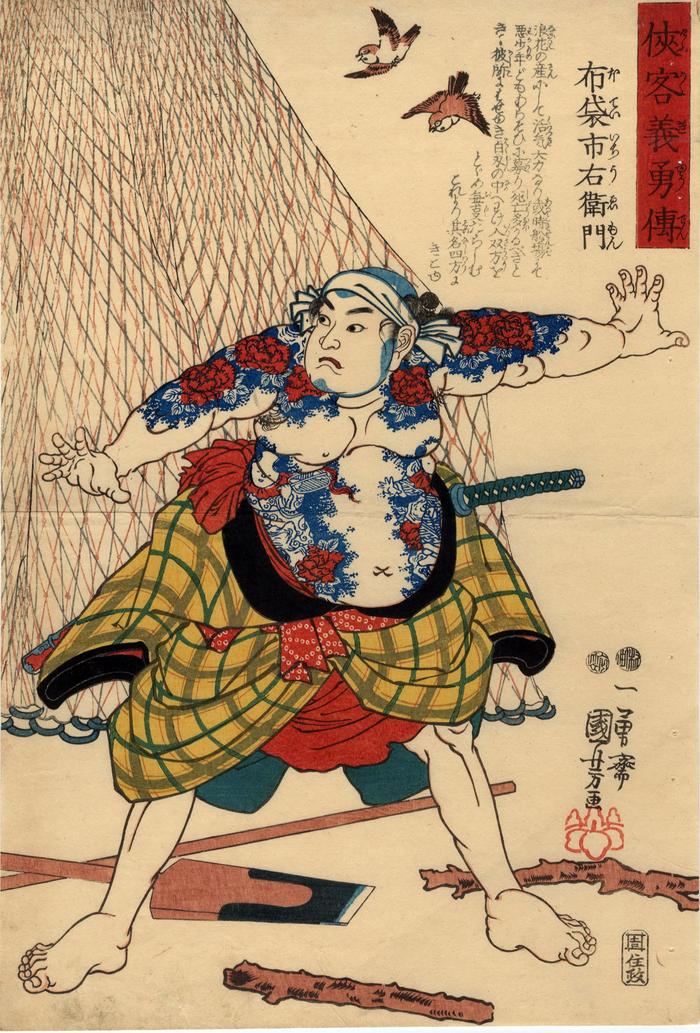Utagawa Kuniyoshi (歌川国芳) (artist 11/15/1797 – 03/05/1861)
Stories of Chivalrous People of Loyalty and Courage (Kyōkaku giyūden - 俠客義勇傅) - Hotei Ichiemon (布袋市右衛門)
1851
9.5 in x 14 in (Overall dimensions) woodblock print
Signed: Ichiyūsai Kuniyoshi ga
一勇斎国芳画 Publisher: Sumiyoshiya Masagorō
(Marks 498 - seal 21-062)
Censor seals: Kinugasa and Murata
Museum of Fine Arts, Boston - ca. 1756 Kiyohiro print of Ichiemon
National Diet Library - Toyokuni III example
Waseda University - a different Kuniyoshi print of Ichiemon
Museum of Fine Arts, Boston - 1841 Sadanobu portrait At first glance, there does not appear to be anything particularly special about this print other than its dramatic pose, the spectacular tattoo on the man's body of two Chinese boys, one holding a fan, in a field of bright red peonies on a blue ground, the placement of the netting, the broken tree limbs on the ground along with a boatman's oar. Even the netting appears to be weighted by iron rings. A nice touch. Oh, and don't forget the two birds, which help create a more natural setting for this scene. But there is one more thing that sets this print apart from all or almost all other representations of Hotei Ichiemon. This is the only one where this character is so scantily clothed. In all other examples we have surveyed Ichiemon is fully dressed in layers of typical robes or kimonos.
We surveyed more than 50 woodblock prints which included Hotei Ichiemon and none of them were as dramatic as this Kuniyoshi example. These included prints from the Osaka and Edo stages and artists from Kiyohiro in 1756, where one actor is partially disrobed, to Shunshō in 1780, Shunkō in 1789, Toyokun I in 1818, Kunihiro in 1822, Toshikuni in 1826 and Sadanobu in 1841. Of course, this is only a partial list. There is even a surimono by Hokusai from ca. 1798 shows Hotei Ichiemon fully enveloped in robes. And, there were numerous actors who played this role from the most famous ones to some who are hardly known today. It is this tradition that makes this Kuniyoshi print in the Lyon Collection so exceptional and worthy of our attention.
****
From the very rare series 'Kyokaku giyu den', from which only three designs are known to survive. Hotei Ichiemon, half-naked and tattooed, with both arms out flung in from of a drying fishing net, about to separate fighting roughs. See the small black and white reproduction in Kuniyoshi: The Warrior Prints by B. W. Robinson, Cornell University Press, Ithaca, 1982, p. 150, S70.2. [The choice of bold type is our own.]
Ex B. W. Robinson and previously the C. H. Mitchell collection whose notes appeared on the cardboard mount (since removed) - this impression used to illustrate the set in The Warrior Prints at page 150.
****
Hotei Ichiemon is one of the 5 Chivalrous Heroes who started out as ruffian brigands, but who were romanticized by the kabuki and puppet theaters into the most admirable commoners around.
Ex B. W. Robinson and previously the C. H. Mitchell collection whose notes appeared on the cardboard mount (since removed) - this impression used to illustrate the set in The Warrior Prints at page 150.
****
Hotei Ichiemon is one of the 5 Chivalrous Heroes who started out as ruffian brigands, but who were romanticized by the kabuki and puppet theaters into the most admirable commoners around.
Many artist created numerous representations of these men. This is the only one, so far, where we have seen Ichiemon tattooed We have added some links above of just a few of these, plus one more by Kuniyoshi.
****
The real-life Hotei Ichiemon (1673-1702)
Hotei Ichiemon, like all of the men who came to be known as otokodate, was a criminal and a rogue who was glamorized in later lore. "Expelled from father's home and became homeless in 1694. Involved in violent crimes from at least 1697, when he enlisted as a member of a gang that included An no Heibei and Kaitate no Kichiemon. Imprisoned in mid-1697, he received clemency on the twenty-fourth day, First Month, 1698, but thereafter joined Seven's Gang. Imprisoned on the twenty-second day, Eleventh Month, 1701, and beheaded on the twenty-sixth day of the Eighth Month, 1702."
Quoted from: Osaka: The Merchants' Capital of Early Modern Japan in an essay by Gary Leupp, 'The Five Men of Naniwa: Gang Violence and Popular Culture in Genroku Osaka', p. 134. (JSV)
****
There is another copy of the center panel in the Worcester Art Museum.
Sumiyoshiya Masagorō (住吉屋政吾郎) (publisher)
Tattoo (genre)
Otokodate - chivalrous men (男伊達) (genre)
